Robin Olds was Built for War
Fighter pilots used to say that there was a glass case in the Pentagon building to the precise dimension of then-Colonel Robin Olds, who would be frozen in time and displayed wearing his tank-less flight suit, crashed fore and aft cap, gloves, and torso harness with .38 pistol and survival knife. Beside the case was a fire ax beneath a sign reading: “In case of war, break glass.”

Biography of Robin Olds
It was something of an exaggeration, but it contained an element of truth: Robin Olds was built for war. And he was born to fly. It was imprinted in his genes. Born July 14, 1922, in Honolulu, Hawaii, Robin Olds was the son of then-Capt. (later Maj. Gen.) Robert Olds and his wife Eloise, who died when Robin was four. The oldest of four, Olds spent the majority of his childhood at Langley Field, Virginia where his father was stationed as an aide to Brig. Gen. Billy Mitchell. In 1925 when he was only three, he accompanied his father to Mitchell’s famed court-martial. Dressed in a child-size air service uniform, he watched his father testify on Mitchell’s behalf. Five years later, young Robin flew for the first time when his father took him up in an open-cockpit biplane.
Deciding on a military career at the age of 12, Olds attended Hampton High School in Hampton Virginia where he became a standout football player. Declining a series of football scholarships, he elected to take a year of study at Millard Preparatory School in 1939 before applying to West Point. Learning of the outbreak of World War II while at Millard, he attempted to leave school and enlist in the Royal Canadian Air Force.
This was blocked by his father who forced him to stay at Millard. Completing the course of study, Olds was accepted to West Point in July 1940 and played for the renowned coach Red Blaik, compiling so stellar a record as a tackle on both offense and defense that in 1985 he was inducted into the College Football Hall of Fame.
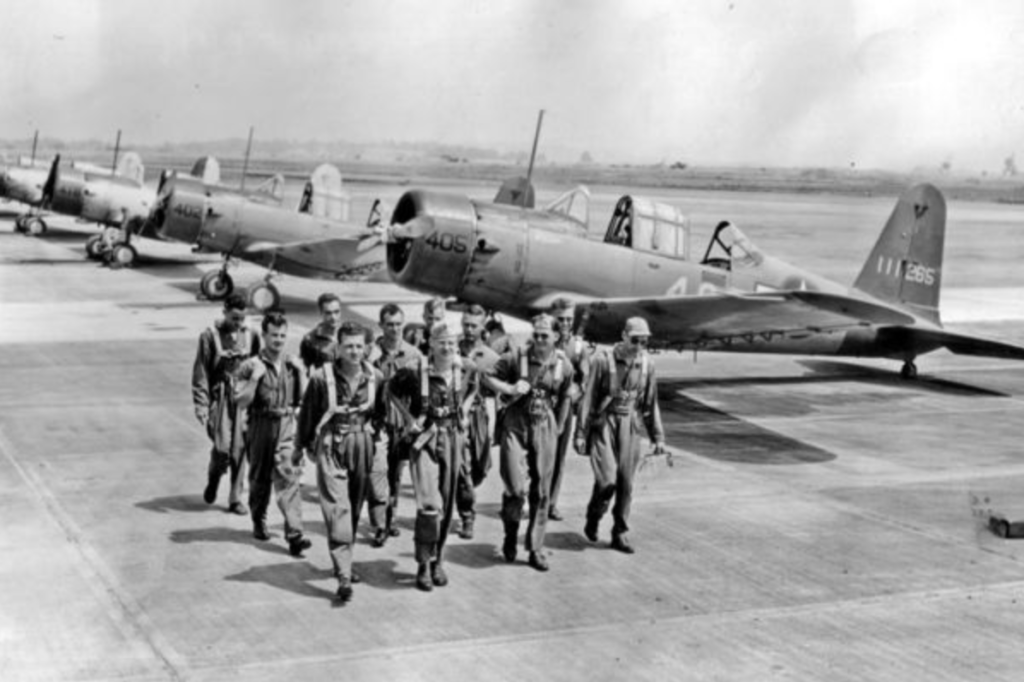
Selecting service in the U.S. Army Air Forces, Olds completed his primary flight training in the summer of 1942 at the Spartan School of Aviation in Tulsa, Oklahoma. Returning north, he passed through advanced training at Stewart Field in New York. Receiving his wings from Gen. Henry “Hap” Arnold, Olds graduated from West Point on June 1, 1943, after completing the academy’s accelerated wartime curriculum. Commissioned as a Second Lieutenant, he received an assignment to report to the West Coast for training on P-38 Lightnings. This done, Olds was posted to the 479th Fighter Group’s 434th Fighter Squadron with orders for Britain.
Arriving in Britain in May 1944, Olds’ squadron quickly entered combat as part of the Allied air offensive before the D-Day invasion of Normandy. Dubbing his P-38J aircraft the “Scat II” (every fighter he flew in combat was named “Scat” and numbered sequentially), Olds worked closely with his crew chief to learn about aircraft maintenance. Promoted to Captain on July 24, on a low-level mission over Montmirail, he spotted two bogeys far in front of him, heading to his right, about 200 feet off the deck.
He pulled behind the two FW-190’s and at 400 yards behind the trailing plane, he fired a six-second burst, hitting the left wing and then pulling his gunfire onto the fuselage. Big pieces flew off, flame and smoke poured out, and the airplane rolled off to the right. Turning his attention to the second plane, he did not see the first one hit the ground. As the second plane pulled a full 360 turn, Olds stayed with him. From dead astern, he fired a five-second burst and observed many hits. The Focke Wulf zoomed up and the pilot bailed out.
On August 25, during an escort mission to Wismar, Germany, Olds shot down three Messerschmitt Bf 109s to become the squadron’s first ace, making him the last P-38 ace of the Eighth Air Force and the last in the European Theater of Operations. He also claimed three more unofficial kills that could not be verified by witnesses.

In mid-September, the 434th began converting to the P-51 Mustang. This required some adjustment on Olds’ part as the single-engine Mustang handled differently than the twin-engine Lightning.
After downing a Bf 109 over Berlin on Oct. 6, Olds completed his initial combat tour in November and was given two months’ leave in the United States. Returning to Europe in January 1945, he was promoted to Major the following month on February 9, and received his seventh aerial victory the same day, using his P-51D’s new K-14 gunsight to calculate the deflection and hit a Bf-109 at 450 yards over Magdeburg with his first burst, a result that surprised even Maj. Olds. He closed in and fired twice more, with his third burst sending the Messerschmitt down in flames. Five days later, on February 14, he claimed three more kills but only received credit for two with the other listed as a “probable.”
On March 25, less than two years out of West Point and at only 22 years of age, Maj. Olds received command of the 434th. He never forgot it. Decades later he said, “As a Major, I was responsible for feeding and housing my men, training my men, and rewarding or punishing them. As a Colonel, I had to check with some general for permission to visit the latrine.”
Unlike many pilots who regarded airplanes as tools, Olds could be sentimental about his machines. Near the end of the war, he was one of six P-51 pilots who attacked a German airdrome and found himself the lone survivor. He nursed his crippled Mustang back to base but found that it stalled at 175 mph, rolling violently. But as he said, “Scat VI had taken me through a lot and I was damned if I was going to give up on her.”
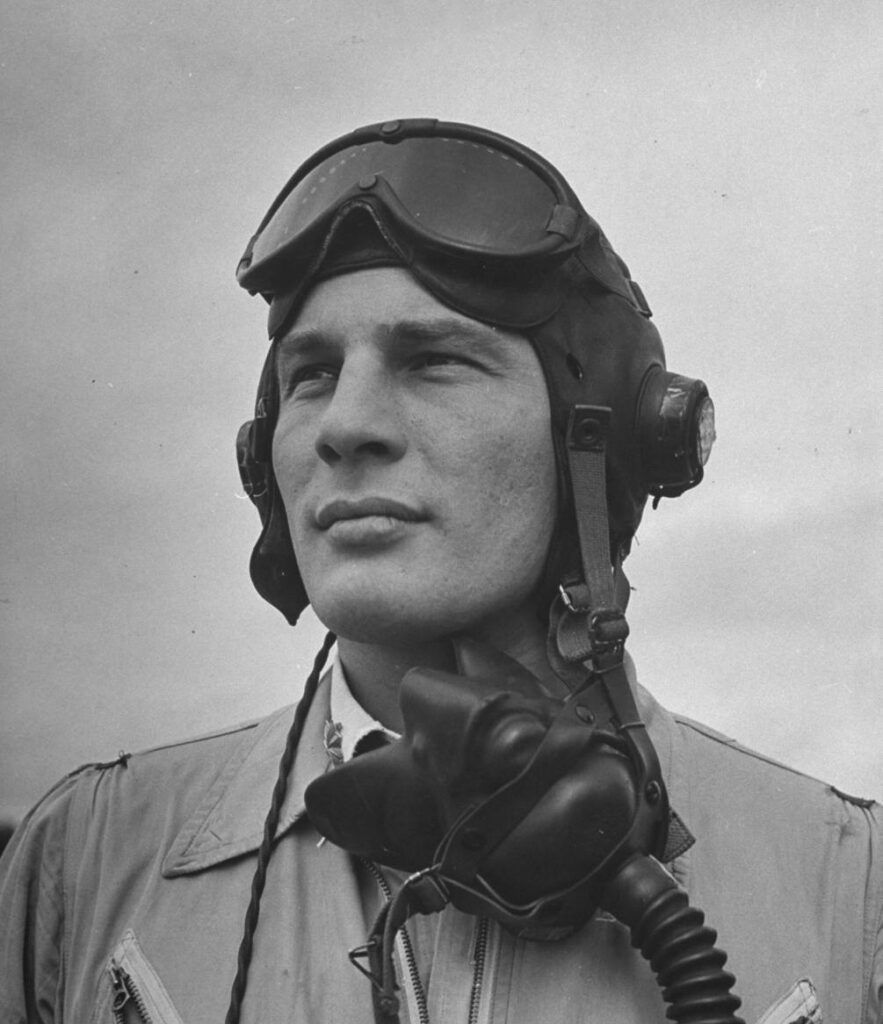
Somehow he got the bird on the runway and kept it in one piece.
Olds was a team player as long as the team wanted to play. When the leaders were only interested in suiting up, he exercised some initiative. In other words, he went freelance. In his first two dogfights, he was alone with his wingman, having left formation to hunt on his own. As he wryly noted long afterward, “When I shot down my first two airplanes I was relieved to see that they had black crosses on their wings.”
Olds used to say that the two best things about World War II were London and Col. Zemke. When the 479th’s first commander was shot down in August 1944, Hub Zemke moved over from the fabled 56th Fighter Group and rejuvenated the Mighty Eighth’s last fighter outfit. Not that Olds needed any rejuvenating, but the group had plodded along in pedestrian fashion.
In a few weeks, Zemke turned things around and added to Robin’s already formidable determination to succeed as a shooter and a leader. The group converted to P-51s in September but on October 30, 1944, while flying in unforecast turbulence, the wing of Zemke’s P-51 was torn off. Zemke was forced to bail out over enemy territory and was captured. He was liberated when the war with Germany ended.
Olds had made ace in both the P-38 and P-51, probably the only pilot ever to do so. Postwar after VE-Day, he returned to the States and reverted to his permanent rank: a 23-year-old Captain.
With the end of the war in Europe in May, Olds’ tally stood at 12 kills as well as 11.5 destroyed on the ground. Returning to the US, Olds was assigned to West Point to serve as an assistant football coach to Earl “Red” Blaik.
Many Older Officers Resented Robin Olds’s Rapid Rise in Rank During the War
Olds’ time at West Point proved brief as many older officers resented his rapid rise in rank during the war. In February 1946, Olds obtained a transfer to the 412th Fighter Group at March Field, California, and trained on the P-80 Shooting Star. Through the remainder of the year, he flew as part of a jet demonstration team with Lt. Col. John C. “Pappy” Herbst.

Robin Olds Met Hollywood Actress Ella Raines on a Blind Date
In 1946, while based at March Field, Olds met Hollywood actress (and “pin-up girl”) Ella Raines on a blind date in Palm Springs. They married in Beverly Hills on February 6, 1947, and had two daughters, Christina and Susan, and a son, Robert Ernest, who was stillborn in 1958. Most of their 29-year marriage, marked by frequently extended separations and difficult homecomings, was turbulent because of a clash of lifestyles, particularly her refusal to ever live in government housing on base. Olds and Ella Raines separated in 1975 and divorced in 1976. Olds then married Abigail Morgan Sellers Barnett in January 1978, and they divorced after fifteen years of marriage.

Ella Raines died on May 30, 1988, Sherman Oaks, California from throat cancer. She was 67.
Seen as a rising star, Olds was selected for a U.S. Air Force-Royal Air Force exchange program in 1948. Traveling to Britain, he commanded No. 1 Squadron at RAF Tangmere and flew the Gloster Meteor. With the end of this assignment in late 1949, Olds became the operations officer for the F-86 Sabre-equipped 94th Fighter Squadron at March Field in California.
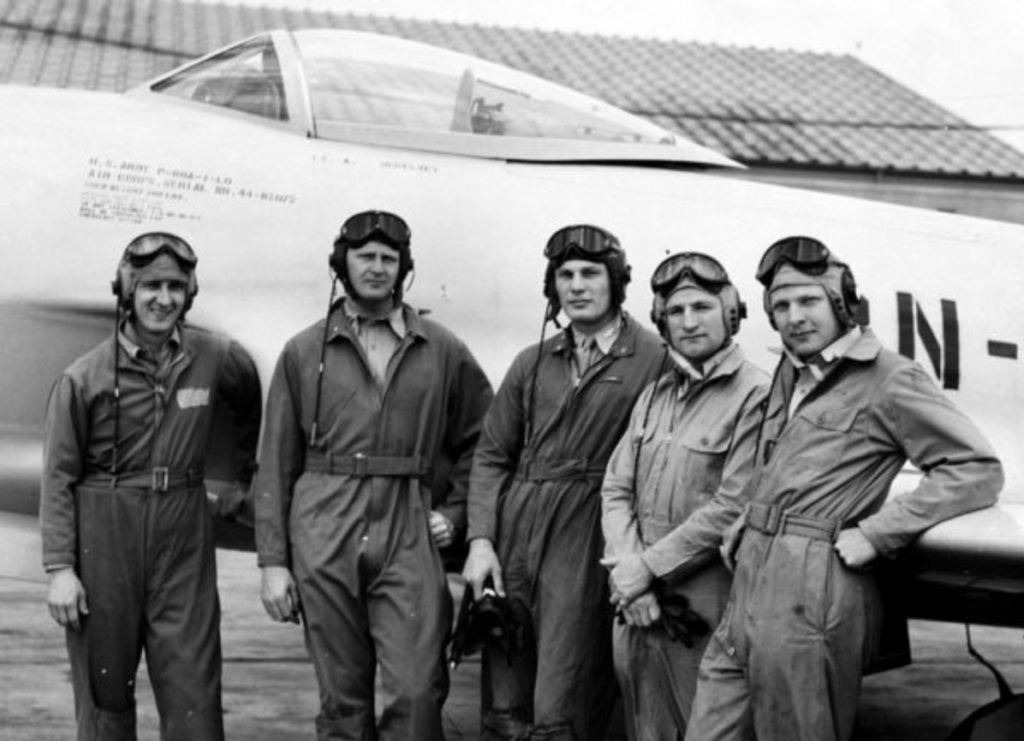
Olds next was given command of the Air Defense Command’s 71st Fighter Squadron based at the Greater Pittsburgh Airport. He remained in this role for much of the Korean War despite repeated requests for combat duty. Increasingly unhappy with the U.S. Air Force, despite promotions to Lieutenant Colonel (1951) and Colonel (1953), he debated retiring but was talked out of it by his friend Maj. Gen. Frederic H. Smith, Jr. Shifting to Smith’s Eastern Air Defense Command, Olds languished in several staff assignments until receiving an assignment to the 86th Fighter-Interceptor Wing at Landstuhl Air Base, Germany in 1955. Remaining abroad for three years, he later oversaw the Weapons Proficiency Center at Wheelus Air Base, Libya.
Made Deputy Chief, Air Defense Division at the Pentagon in 1958, Olds produced as series of prophetic papers calling for improved air-to-air combat training and the increased production of conventional munitions. After assisting in generating the funding for the classified SR-71 Blackbird program, Olds attended the National War College in 1962-1963. Following graduation, he commanded the 81st Tactical Fighter Wing at RAF Bentwaters. During this time, he brought over former Tuskegee Airman Col. Daniel “Chappie” James, Jr. to Britain to serve on his staff. Olds left the 81st in 1965 after forming an aerial demonstration team without command authorization.
After brief service at Shaw AFB in South Carolina, Olds was given command of the 8th Tactical Fighter Wing (TFW) at Ubon Royal Thai Air Force Base. He knew from his sources that all was not well in the 8th TFW and resolved to see it from the perspective of the FNG (the “freaking” new guy).
He went through the normal in-processing routine like any other newbie, paid close attention and spoke little. By the time he reached the front office, he reckoned that he knew all he needed to. He began cleaning house.

First, he cut loose the deadwood, the ticket punchers and careerists who had “sniveled some counters “- missions that counted toward completion of a tour when in fact they had not gone north. Then he began learning the way the Wolfpack did business so he could improve upon it. He stood before the F-4C Phantom crews and said, “I’m going to start here by flying Green Sixteen (tail-end Charlie) and you guys are going to teach me how. But teach me fast and teach me good, because I’m a quick learner.”
Sitting in the audience was Capt. Ralph Wetterhahn, a future MiG killer. Like so many other pilots and WSOs, he was energized by the new CO’s press-on attitude. Years later, Wetterhahn compared Olds’ arrival with that of Brig. Gen. Frank Savage (Gregory Peck) in Twelve O’clock High.
The old ways were not only out, they were deceased. A new regime had arisen, and the Wolfpack began showing results. Olds ruled over a fiefdom like a feudal baron, enjoying the excitement of the hunt by day and discussing the great game with his men at arms by night.

Under Olds’ predecessor, who seldom flew combat, the 8th had eked out a meager kill-loss ratio. Like the rest of the Air Force, it had barely broken even with Hanoi’s MiGs, peaking at a 2-1 exchange rate. Under Olds, the Wolfpack shot to the top of the Southeast Asia league, bagging 18 MiGs, and when he left, the wing’s kill ratio stood at 4-1.
The free-wheeling environment at Ubon fueled morale, and the Wolfpack’s was stratospheric. Dedicated consumers of booze and red meat, they reveled in the warrior ethic. In contrast, today’s sedate, sober young professionals are superbly educated, highly competent, and terrified that they might say something that somebody would find objectionable. Olds did not want to live in that world.
And he didn’t.
Robin Olds designed “Operation Bolo” in late 1966
Increasing concerned about F-105 Thunderchief losses to North Vietnamese MiGs during bombing missions, Olds designed “Operation Bolo” in late 1966. This called for 8th TFW F-4s to mimic F-105 operations in an effort to draw enemy aircraft into combat. Implemented in January 1967, the operation saw American aircraft down seven MiG-21s, with Olds shooting down one. The MiG losses were the highest suffered in one day by the North Vietnamese during the war. A stunning success, Operation Bolo effectively eliminated the MiG threat for most of the spring of 1967. After bagging another MiG-21 on May 4, Olds shot down two MiG-17s on the 20th to raise his total to 16, including the four MiGs over Vietnam.
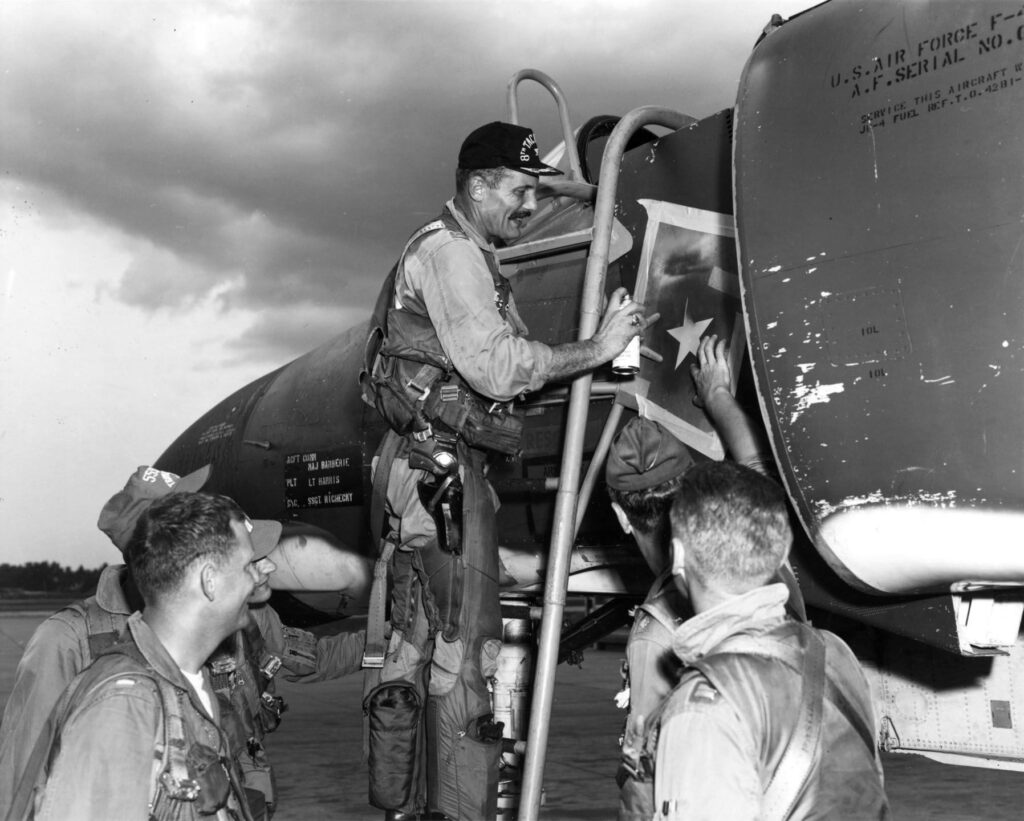
Robin Olds Began Growing a Famed Handlebar Mustache
Over the next few months, Olds continued to personally lead his men into combat. In an effort to raise morale in the 8th TFW, he began growing a famed handlebar mustache. Copied by his men, they referred to them as “bulletproof mustaches.” During this time, he avoided shooting down a fifth MiG as he had been alerted that should he become an ace over Vietnam, he would be relieved of command and brought home to conduct publicity events for the Air Force. On August 11, Olds conducted a strike on the Paul Doumer Bridge in Hanoi. For his performance, he was awarded the Air Force Cross.
Upon return to the U.S., Olds was acclaimed as America’s top gun of the war to date, a record he retained for the next five years. But he was contemptuous of the Air Force’s attitude toward air combat, exclaiming, “The best flying job in the world is a MiG-21 pilot at Phuc Yen. Hell, if I was one of them I’d have got 50 of us!”
Despite his MiG-killing fame, he was perhaps proudest of the strike against North Vietnam’s best-defended target: Thai Nguyen steel mill. In an ultra-low-level attack, leaving rooster tails on the paddies behind them, Olds and two wingmen put their bombs on target. He considered it a dangerously wasteful effort, as the mill had been hit repeatedly, but its smokestacks had remained standing. What he valued most was the courage and skill of his aircrews.

Leaving the 8th TFW in September 1967, Olds was made Commandant of Cadets at the US Air Force Academy. Promoted to brigadier general on June 1, 1968, he worked to restore pride in the school after a large cheating scandal had blackened its reputation. In February 1971, Olds became director of aerospace safety in the Office of the Inspector General. That fall, he was sent back to Southeast Asia to report on the combat readiness of USAF units in the region. While there, he toured bases and flew several unauthorized combat missions.
He found what he feared: most Air Force fighter crews “couldn’t fight their way out of a wet paper bag.” Commander John Nichols, a Navy MiG killer brought to Udorn, Thailand to teach dogfighting to the Air Force blue suits, saw Olds taxi his F-4 into the chocks after a practice mission. “The canopy came open, followed by General Olds’ helmet in a high, lofting arc. He was not happy.” But his report and analysis were not well received, and his recommendations were ignored.
When Operation Linebacker began in May 1972, American fighter jets returned to the offense in the skies over North Vietnam for the first time in nearly four years. Navy and Marine Corps fighters, reaping the benefits of their TOPGUN program, immediately enjoyed considerable success with a 12:1 kill-loss ratio. In contrast, by June, as Olds had predicted, the Air Force’s fighter community was struggling with a nearly 1:1 kill-loss ratio.
Robin Olds Decided to Leave the Air Force
To the new Inspector General, Lt. Gen. Ernest C. Hardin, Jr., Olds offered to take a voluntary reduction in rank to Colonel so he could return to operational command and straighten out the situation. Olds decided to leave the Air Force when the offer was refused (he was offered another inspection tour instead) and he retired on June 1, 1973. With 17 career victories (thirteen in WW II plus four in Vietnam) when the triple ace died, he was America’s third-ranking living ace. His 259 total combat missions included 107 in World War II and 152 in Southeast Asia, 105 of those over North Vietnam. Scat XXVII (F-4C-24-MC 64-0829), the plane he flew for his four MiG kills, was retired from operational service and placed on display at the National Museum of the United States Air Force, Wright-Patterson Air Force Base, Ohio, with the four red MiG stars representing his four MiG kills in Vietnam painted on the splitter vane of the intake.
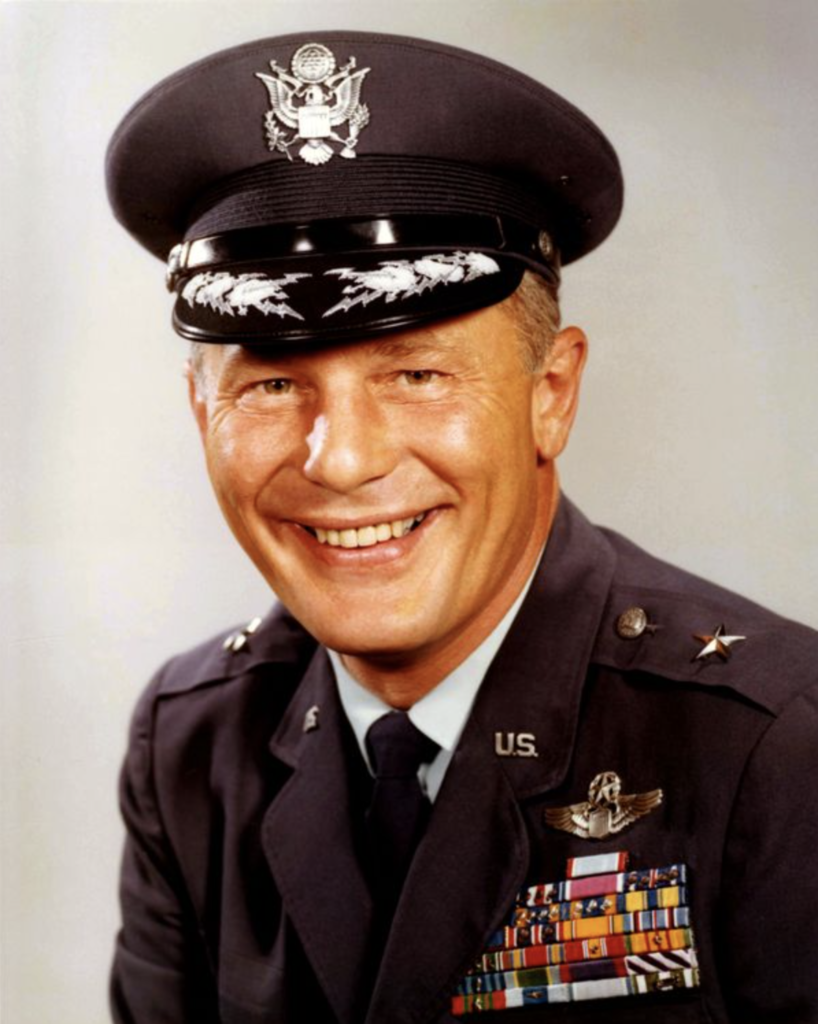
Retiring to Steamboat Springs, CO, he became active in public affairs. Enshrined in the National Aviation Hall of Fame in 2001, Olds later died on June 14, 2007. His ashes were interred at the US Air Force Academy.
Far too many military personnel, policemen, and politicians mouth their oath of office as a rote exercise. Not Robin Olds. He thought about the words, absorbed, them, and passed them along. In addressing newly commissioned officers he said, “The airman swears that he will obey the orders of the officers appointed over him. Do you realize what responsibilities that put on your shoulders? Your orders have to be legal and proper. Think about it, before you give one. But think about how to protect and defend the Constitution. Because do you know what that is? That is by, for, and of The People. It is not the President; it is not the Speaker of the House; nor the Leader of the Senate. It is the People of the United States; who, hopefully in their wisdom will guide their forces properly.”
Robin Olds Once Said his Magnificent Mustache Represented his Defiance
Olds had been writing a memoir for several years prior to his death. Says F-4 pilot and novelist Mark Berent, “It was well written, as you’d expect from Robin, but it wasn’t really about him. It was more about people he knew.”
Another Air Force officer who read part of the text said that it began as an ethereal discussion with the ghost of Robin’s father. Robert Olds had asked his son the status of the U.S. Air Force and got a detailed debriefing on what’s wrong with the service. It was a long list.

When he died on June 14, not quite 85, Olds left the work incomplete. The fact that his book remains unfinished represents a major loss to aviation literature.
Gen. Robin Olds once said his magnificent mustache represented his defiance. This defiance grew into the modern-day practice called “Mustache March” in the U.S. Air Force, in which Airmen of all ranks grow their mustaches out of regulations for the entire month of March in defiance of AF hair grooming standards.
Read About Other Profiles in Courage
If you enjoyed learning about Col Robin Olds, we invite you to read about other profiles in courage on our blog. You will also find military book reviews, veterans’ service reflections, famous military units and more on the TogetherWeServed.com blog. If you are a veteran, find your military buddies, view historic boot camp photos, build a printable military service plaque, and more on TogetherWeServed.com today.
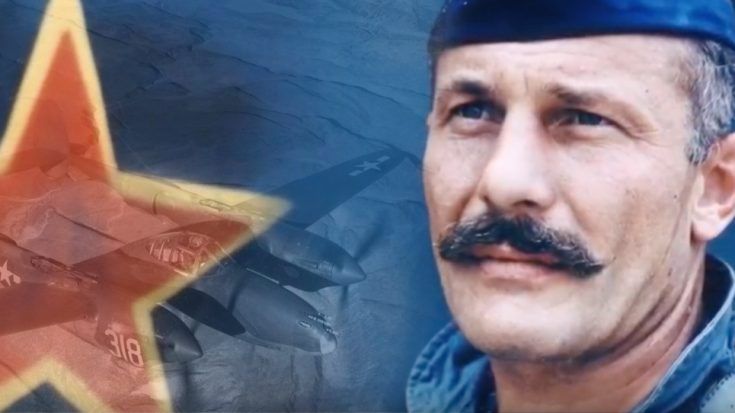
I was stationed at RAF Bentwaters while Col Olds was the wing commander and Lt Col “Chappy” James was the DO. It was the best assignment I had during my almost 12 years in the USAF. I was assigned to Base Operations and they were both frequent visitors. Col Olds had several general assemblies with the support staff and they were always motivational. The wing had converted to the F101 and he loved to show us what it could do during annual air shows. Lt Col James was as motivational whenever I saw him speak,
After reviewing and reading through this list, I am surprised that there was nothing written about General Chappy James who played a significant role in the F105 operations in North Vietnam.
Surprised, no disappointment yes. Recognition for minority heroes is often ignored more than anyone realizes. recognition is often delayed or or never even happens (or it happens posthumously ) I was thrilled today to see Pres. Biden give the Medal of Honor to Col Paris D. Davis …..MANY years late. His nomination for recognition was shuffled around the Pentagon for close to SIX decades! Shameful .
I was stationed at Ubon Thailand 1970 the classic Robin Olds handlebar mustache was still allowed. Naturally I grew one and then awards the end of my tour we got some state side weenies that pushed the no handlebar mustache .Disn
t help moral much. Hie daughter wrote Fighter Pilot great tribute to the great Robin Olds
.